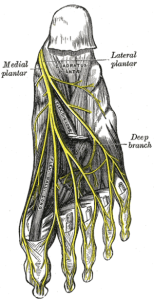Morton’s Neuroma: Taking a Closer Look
March 28 2023
What is Morton’s Neuroma?
Dr. Chapman provides an overview with common symptoms and treatment options.
Overview:
- History
- What is Morton’s Neuroma?
- Symptoms
- Treatment Options
Though Morton’s Neuroma is one of the three most common disorders of the foot, it seems to receive less attention than plantar fasciitis or bunions. Considering approximately 200,000 cases are diagnosed each year in the U.S., it deserves a closer look.
It took some digging to discover how a foot neuroma was named Morton’s neuroma. Turns out there were two Dr. Mortons: Thomas G. Morton was a professor of orthopedic surgery at the Philadelphia Polyclinic in 1876. he also was surgeon to the Pennsylvania Hospital and to the Orthopedic Hospital and Infirmary for Nervous Diseases.
T.K. Morton, a professor of clinical surgery of clinical surgery at the Pennsylvania Hospital and consulting surgeon to the Philadelphia dispensary, is thought to have been Thomas G. Morton’s son; he also described the neuroma, in 1890.
What is Morton’s Neuroma?
A neuroma is a benign nerve tumor. Morton’s neuroma – also called metatarsalgia – is not really a tumor, but an enlargement of the tissue that surrounds the digital nerve leading to the toes. It usually happens between the third and fourth toes; sometimes the second and third toes. The neuroma makes your foot feel like there’s a pebble in your shoe, causing irritation at the base of the toes. Common symptoms include tingling, burning, numbness, and shooting pain. The pain occurs gradually and gets worse over time, ultimately restricting any kind of weight bearing activity.
Morton’s Neuroma Statistics
Women are 8-10 times more likely to develop Morton’s neuroma. People with foot issues like hammertoes, flat feet or bunions are also more prone to developing the disorder.
Other causes of Morton’s neuroma include:
- Wearing high heels, which compress the toe bones, pinch the nerve, and add stress to the front of the foot
- Wearing shoes with a too-tight toe box, or that don’t fit properly
- Foot deformity
- Traumatic foot injury
- Repetitive force, especially from running, tennis and other court sports
When it comes to treatment for metatarsalgia, the diagnosis is extremely important in the success of any treatment program. A specific diagnosis means treatment can be far more specific in addressing the cause which leads to more successful outcomes. Various foot problems can cause symptoms in the forefoot resembling metatarsalgia.
Imaging is a great way to help diagnose forefoot complaints. A referral for an x-ray and ultrasound can be arranged by your podiatrists if needed. The goal of treatment and rehabilitation is to restore normal range of motion, strength and function of the foot.
Initial treatment will usually involve a number of strategies to reduce pain and prevent recurrence.
Treatment Options
A Morton’s neuroma doesn’t usually go away on its own. Failure to seek treatment can result in surgical intervention and/or permanent nerve damage. Experts estimate that up to 33% of all people with pain in the ball of their foot have an undiagnosed Morton’s neuroma.
Once a thorough examination and x-ray have confirmed the diagnosis, your podiatrist might recommend:
- NSAIDs
- Icing to manage pain and swelling
- A corticosteroid injection to reduce inflammation and reduce pain
- Limited wight-bearing activities
- Wearing only select, well fitted shoes
- Custom-fitted orthotic inserts with metatarsal pods to reduce pressure on the nerve and foot
- Extracorporeal Pulse Activated Technology (EPAT) treatments
EPAT uses high-frequency sound waves to break down scar tissue and promote blood vessel growth and healing. Approved by the FDA, it is the most advanced treatment being used today. It’s non-invasive and can be very effective in treating Morton’s neuroma, often obviating the need for surgery.
 Are you experiencing symptoms? You can contact Dr. Chapman’s office at (239) 430-3668 (FOOT) or visit NaplesPodiatrist.com to schedule an examination.
Are you experiencing symptoms? You can contact Dr. Chapman’s office at (239) 430-3668 (FOOT) or visit NaplesPodiatrist.com to schedule an examination.
Dr. Drew Chapman is a podiatric physician and surgeon practicing in Southwest Florida. Double Board Certified: American Board of Foot and Ankle Surgery.
—————–



 Fax: (239) 692-9436
Fax: (239) 692-9436 Tel: 239-430-3668
Tel: 239-430-3668
